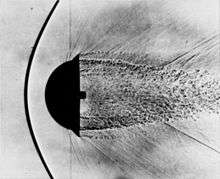Bow shock (aerodynamics)

A bow shock, also called a detached shock or normal shock, is a curved, stationary shock wave that is found in a supersonic flow past a finite body. The name comes from the example of a bow wave that forms at the bow of a ship when it moves through the water.
Unlike an oblique shock, the bow shock is not necessarily attached to the tip of the body. Oblique shock angles are limited in formation and are based on the flow deflection angle, upstream Mach number. When these limitations are exceeded (greater deflection angle or lower Mach number), a detached bow shock forms instead of an oblique shock. As bow shocks form for high flow deflection angles, they are often seen forming around blunt objects. In other words, when the needed rotation of the fluid exceeds the maximum achievable rotation angle for an oblique attached shock, the shock detaches from the body. Downstream of the shock, the flow-field is subsonic, and the boundary condition can be respected at the stagnation point.
The bow shock significantly increases the drag in a vehicle traveling at a supersonic speed. This property was utilized in the design of the return capsules during space missions such as the Apollo program, which need a high amount of drag in order to slow down during atmospheric reentry.
See also
References
- Landau, L.D.; Lifshitz, E.M. (2005) [1959]. Fluid Mechanics 2nd edition. Elsevier. ISBN 0-7506-2767-0.
- Courant, R.; Friedrichs, K.O. (1956) [1948]. Supersonic Flow and Shock Waves. Interscience Publishers, Inc., New York.